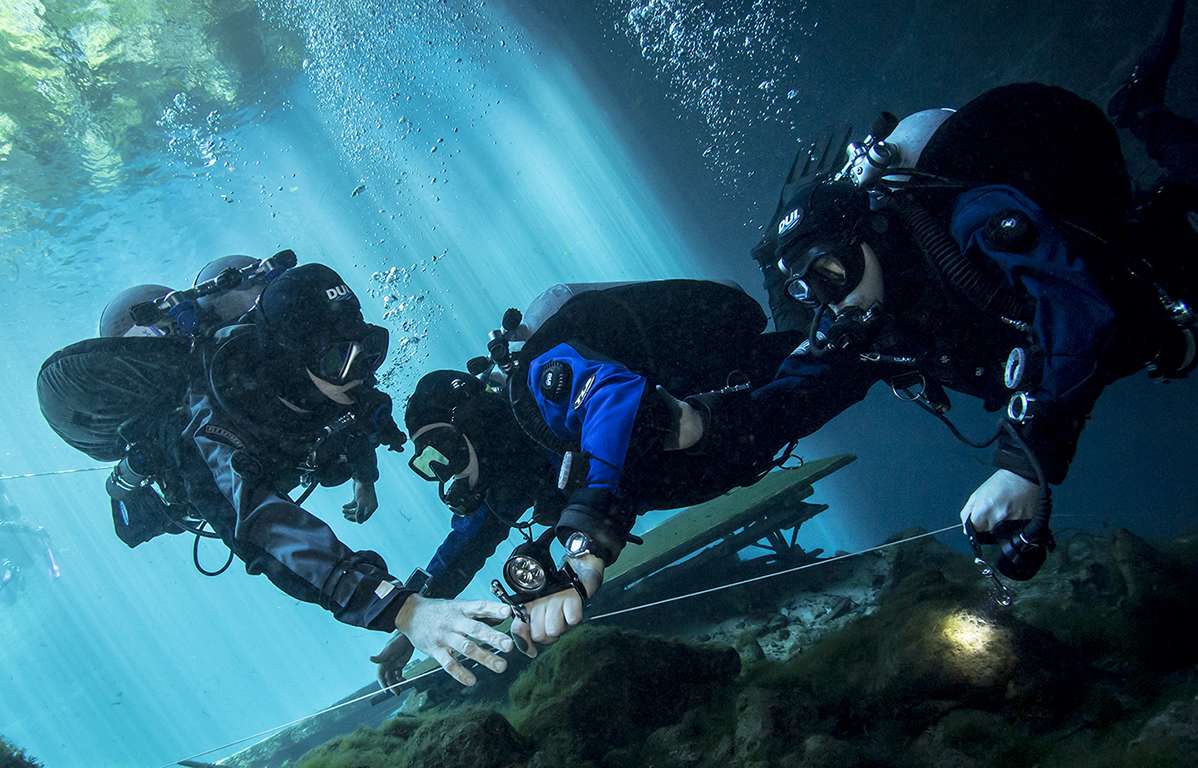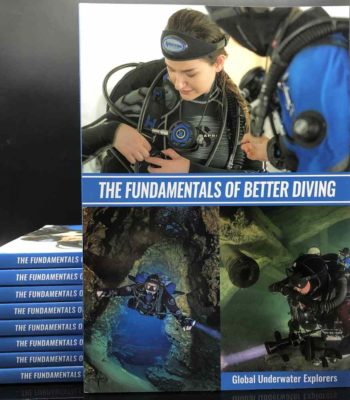
Rosemary E Lunn reviews the Global Underwater Explorers’ (GUE) recently updated manual Doing It Right: The Fundamentals of Better Diving
I have been carrying a copy of this book around for a few months, and when I’ve had an odd quiet five minutes, I’ve flicked it open at a random page and dived in.
The book echoes the GUE brand – it has a high production finish – the layout is clean and uncluttered. The prose is nicely written in plain English (it’s an easy read), and it benefits from some smashing images, several of which have been shot by Jesper Kjoller. The photographers and the picture editor have certainly done a cracking job because the working photos (for example, the GUE regulator configuration on a twinset or a single/twin tank configuration) are clean, simple to understand, and a useful aide-mémoire. If I were to apply the ‘Woke’ filter, I would say this book is a bit too bloke image-heavy. I would have liked to see more women pictured, but frankly, that is me nitpicking.
The Fundamentals of Better Diving has been designed and laid out to be a working manual – I like the fact that decent margins have been included throughout the book so that the reader can scribble notes should they wish. In addition, all measurements are in metric and imperial, and there are some handy formulas in the appendix.
There are going to be two types of divers that buy this book.
Firstly, anyone who is seriously considering, or even toying with the idea of doing a GUE course to master their skills, ought to buy and devour this book. It will help you understand the GUE ethos and philosophy – why do they train as they do, why do they use such kit configurations, and much more.
GUE training and diving is not for every diver, but certain aspects of GUE training and diving ought to be adopted by every diver. Let’s face who doesn’t want to look flat and sexy in the water (have optimal trim) and be able to fin backwards?
You can certainly see that today GUE is influencing some mainstream teaching and diving. Other agencies now place far more emphasis on neutral buoyancy training and practising skills midwater, rather than advocating trainee diver kneel on the bottom of the pool. This is a good thing. How are you going to learn good neutral buoyancy? By getting in the water and practising it! You cannot replace sheer in-water time.
This is not a cosy read, and the authors have not held back and issued some highly relevant if painful, advice.
‘Dive computers have a tendency to remove the diver’s experience, intelligence, and knowledge from both the planning and execution phases of the dive.’
Absolutely. I concur.
I have heard some horror stories where ill-educated divers have had a stop come up on their computer, and because they have not been taught about dive planning and computers properly, they have thought they have done something wrong. Their response? To instantly bolt for the surface and blow through the stop. Yeah, gods!
The second kind of diver who will buy this book is the curious diver. And I sincerely hope it will be the ones that are asking a lot of questions on social media that are making my toes curl. I read these questions with some degree of concern because what is being asked should have already been taught, and I worry about some instructors’ quality and experience.
Again, the GUE book does not hold back, and similarly, I agree with their opinion.
‘Shortening the education process as a means of creating cheap classes does not foster a culture of accomplished divers.’
‘Why does the industry continue to promote the idea that diving requires little or no effort, no dedication, and no requirement to be proficient?’
Ill-trained divers
We are reaping the results of cheap, short classes. Ill-trained divers venture on an open water dive and surface scared, and then stop diving because they think this is what scuba diving is all about, and it isn’t! No wonder we are seeing a non-diver enter our sport, do a course or two and give up about 12 to 18 months later.
I am a classic example of a dive going badly wrong very early in my dive career. I had an uncontrolled ascent from 30 metres after a 25-minute bottom time on my first dive outside training. I was told that because I was certified to 30 metres, I could go and explore the wreck of the Kyarra, sunk off the Eglish south coast It was my tenth dive, and my buddy was someone vastly more experienced than I. He had 14 dives! I don’t know how we didn’t suffer an embolism or die. It mentally scarred me for life. If I hadn’t been so driven to learn to scuba, I would have walked away from diving at that point.
I persisted, did my research and got lucky. I’ve been taught by some superb instructors who adopt the ‘train hard, dive easy’ principle; consequently, I am still diving, I am still hungry to learn more. Still love this sport nearly 30 years after my first open water dive, and hence, I’m writing this book review during a surface interval. I am exploring the west coast of Scotland, more specifically, the Sound of Mull wrecks. This diving is not for the faint-hearted; you need to be properly trained and have some grit about you.

If you don’t like the weather, it’s okay, just wait a few minutes, and it will change. Today we have had torrential rain, walls of water, brilliant sunshine spells, some spectacular rainbows, a bit of sleet, and the cycle starts again.
The viz on the wrecks has been varied. From dire to not bad. The wrecks continue to evolve, and the marine life has been quite pretty. But if I hadn’t been trained properly and then practised diving temperate waters off a British hardboat, I would have had an all mother of the dive on the Hispania this morning. Yes, the current was running, and the viz was low, and it was harder than I would have liked it, but I was able to conduct a safe, fun dive, and surface fit and well because I know and comply with shot protocols, currents, wreck hazards etc.
If you are a new diver or a more experienced diver who has not been optimally trained, of course, you would have had a nightmare during this morning’s dive because you have not had enough time in the water to master skills, or your instructor was not that experienced, and didn’t add in the golden information or technique nuggets you so desperately need. You have a scary dive and think ‘right, that is me done. I have my diving ticket; I am never diving again’. Instead of persevering, having a better dive, practising and getting more out of your underwater adventures.
Credible source
Why do I mention all of this? I can see the curious diver, who has not got the answers and education they should have, picking up this book and learning beneficial, sound diving practices from a credible source.
Yes, there is a bit of ‘GUE is the only way’. ‘The righteous path to real diving’, blah, blah, blah. And of course, the die-hard GUE devotees will lap it up, while the rest of us will smile and turn the page. That doesn’t mean this book does not have value – you certainly don’t need to be a diehard GUE disciple to benefit from the useful information this book contains.
The ten chapters in ‘The Fundamentals of Better Diving’ cover useful topics such as refined propulsion, choosing a gas mix and equipment configuration. You get straight answers and solid advice about essential dive skills, such as which should you use for primary buoyancy and why? Wing? Or drysuit? The answer is probably the best I have read to date. It is logical, structured and sensible.

The Fundamentals of Better Diving is currently available in six languages (Chinese, English, German, Italian, Korean, Spanish) and can be purchased via GUE.com


